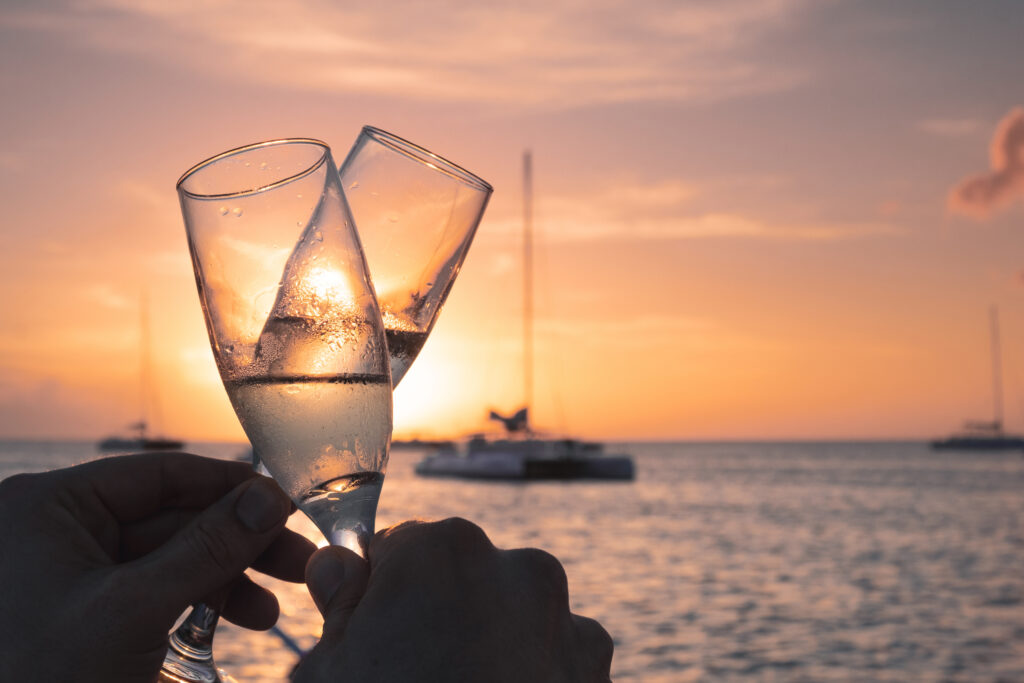

Ever walk into a room and instantly feel like you missed the memo—or maybe you’re humbled that you skipped cotillion altogether? Same. In a world where Home Ec is extinct and etiquette is more TikTok than textbook, I’m here to clear the fog around champagne goblets. Because when it’s time to raise a glass, you deserve to do it with confidence—and maybe a little sparkle, too. 🥂
Let’s talk champagne glasses. Not the dusty set you inherited from Aunt Stella, or the “close enough” wine glass you grabbed mid-toast. I mean the right glass—the kind that makes your bubbly taste like it came with a private string quartet and a luxury cruise voucher.
Once upon a time (aka your mom’s bridge night in the ‘60s), it was all about the wide, shallow coupe—very retro glam. Fast forward to today, and the tulip flute has taken center stage at bridal showers and bottomless brunches alike.
But… which one is actually correct?
Like any woman who’s ever Googled “can I wear white after Labor Day?”, I had questions. So I did a little deep dive—okay, a borderline obsessive research spiral—and now I’m spilling the sparkling secrets.
Here’s the thing: when I host a party, (or if I end my week with a Friday), there is always champagne. It’s festive. It’s fabulous. It’s a whole mood.
But I’ve found myself standing in my kitchen, bottle in hand, asking life’s big questions:
“Am I using the wrong glass?”
“Will my guests judge me if I serve Veuve in a flute?”
“Is my glassware holding me back emotionally?”
The truth is, the right goblet does matter—and not just for Instagram aesthetics. It changes how your champagne smells, tastes, and yes, fizzes.

I used to think keeping the bubbles locked in was the goal—like, don’t you dare let them escape. Turns out, champagne benefits from a little air. Just like red wine, it needs to breathe to reveal all its juicy secrets.
The catch? You’ve got to do it without killing the fizz. It’s a delicate dance—like dating in your 30s.

Photo by Nicky Pe
This might sound extra (and honestly, I love that for us), but pros recommend decanting your champagne in a chilled glass decanter. Yep, not just for Bordeaux anymore.
The trick is choosing one with a narrow mouth—that way, you get all the aromatic magic without letting the bubbles peace out early. Think: letting it breathe, but not bolt.
Will I now be the one who chills her decanter before guests arrive? Probably. And I’m okay with that.
Let’s review our options:
Enter the champagne tulip. It starts with a wide bowl (hello, flavor), then curves in at the top to trap those precious bubbles. It’s basically a power couple in glass form—a flute and coupe had a baby, and she’s thriving.
Bonus: It just looks grown-up. The kind of glass that says, yes, I have a skincare routine and a favorite Napa producer.
There are plenty of gorgeous, budget-friendly options that look luxe but don’t require a second job. I’m loving the Joy Jolt Layla Collection Champagne Flutes—elegant shape, solid weight, and affordable enough to stock up for your next girls’ night in (with matching robes, obviously).
Look, if you’re still using one universal glass for wine, cocktails, and a rogue iced coffee… you’re not alone. We’ve all been there.
But investing in the right stemware is like upgrading from drugstore moisturizer to a cult-favorite serum. Suddenly, things just… work better. Well, not always, but you get the analogy.

So take your time. Start with a good set of champagne goblets. Try decanting once in a while. You don’t have to be a sommelier—you just have to know what you love, and lean in with a little flair.
Because when it comes to bubbles, it’s not just about what’s in the glass—it’s the whole experience. And you, my friend, are the main character.
And remember, accoutrements are important if you want to truly enjoy a beverage the way the winemaker intended it.
